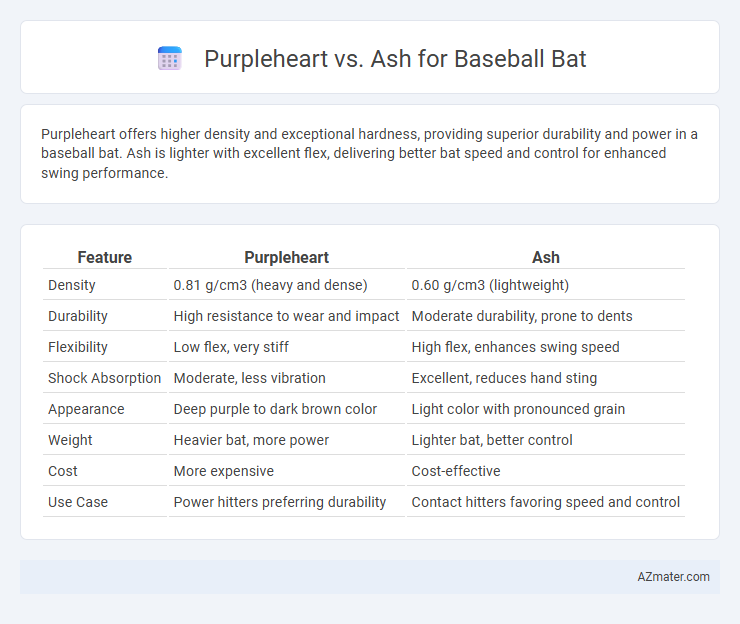Purpleheart offers higher density and exceptional hardness, providing superior durability and power in a baseball bat. Ash is lighter with excellent flex, delivering better bat speed and control for enhanced swing performance.
Table of Comparison
| Feature | Purpleheart | Ash |
|---|---|---|
| Density | 0.81 g/cm3 (heavy and dense) | 0.60 g/cm3 (lightweight) |
| Durability | High resistance to wear and impact | Moderate durability, prone to dents |
| Flexibility | Low flex, very stiff | High flex, enhances swing speed |
| Shock Absorption | Moderate, less vibration | Excellent, reduces hand sting |
| Appearance | Deep purple to dark brown color | Light color with pronounced grain |
| Weight | Heavier bat, more power | Lighter bat, better control |
| Cost | More expensive | Cost-effective |
| Use Case | Power hitters preferring durability | Contact hitters favoring speed and control |
Introduction to Purpleheart and Ash Baseball Bats
Purpleheart baseball bats are known for their exceptional hardness and vibrant purple hue, offering superior durability and resistance to impact compared to many traditional woods. Ash bats remain popular for their lightweight feel and excellent flex, providing a great balance of speed and power for hitters. Choosing between Purpleheart and Ash involves considering factors like weight distribution, hardness, and personal preference for swing speed and bat longevity.
Wood Characteristics: Purpleheart vs Ash
Purpleheart wood, known for its extreme density and durability, offers superior hardness and impact resistance, making it ideal for power hitters seeking long-lasting performance. Ash wood, valued for its lightweight and excellent flexibility, provides a balanced swing speed and strong shock absorption, enhancing control and comfort during play. The choice between Purpleheart and Ash depends on whether players prioritize bat strength and longevity or a lighter, more maneuverable feel.
Durability and Strength Comparison
Purpleheart wood exhibits exceptional durability and high hardness, making it highly resistant to wear and impact, which is essential for baseball bats subjected to intense swings and ball contact. Ash wood, favored for its flexibility and shock resistance, offers a balanced combination of strength and lightweight characteristics, but it generally has lower hardness compared to Purpleheart. When comparing durability, Purpleheart outperforms Ash in hardness and long-term wear resistance, although Ash provides better flexibility, reducing the risk of cracking under repeated stress.
Weight and Balance Differences
Purpleheart baseball bats typically have a denser, heavier composition, resulting in a bat with increased weight that can generate powerful hits but may require more strength to swing efficiently. Ash bats are lighter and offer excellent balance and flexibility, allowing for quicker swings and enhanced control at the plate. The weight distribution in Purpleheart bats often feels more concentrated, while Ash provides a more evenly balanced feel, catering to players prioritizing speed and maneuverability.
Performance Impact: Power and Control
Purpleheart offers exceptional density and hardness, resulting in greater power and enhanced durability for baseball bats designed to deliver strong, solid hits. Ash provides superior flexibility and lighter weight, improving bat speed and control, which benefits players seeking better swing precision and quicker reaction times. Choosing between Purpleheart and Ash hinges on the desired balance of raw power versus control, with Purpleheart favoring power-focused performance and Ash optimizing bat maneuverability.
Shock Absorption and Vibration Handling
Purpleheart baseball bats exhibit superior shock absorption due to the wood's high density and hardness, effectively minimizing sting on the hands after impact. Ash bats, known for their flexible grain structure, excel at vibration handling by dissipating energy more evenly across the bat, providing a smoother feel during swings. While Purpleheart offers enhanced durability against shock, Ash delivers a balanced vibration response preferred by players seeking comfort and control.
Aesthetic Appeal and Grain Patterns
Purpleheart offers a striking deep purple hue that darkens over time, providing a unique and eye-catching aesthetic for baseball bats, while its fine, straight grain adds durability and smoothness. Ash, known for its light color and classic look, features a prominent, attractive grain pattern with wide, contrasting streaks that contribute to its traditional sporting appeal. Both woods showcase distinctive grain patterns, with Purpleheart emphasizing exotic richness and Ash highlighting a timeless, natural texture favored in bat craftsmanship.
Price and Availability of Purpleheart vs Ash
Purpleheart baseball bats tend to be more expensive than ash bats due to the rarity and density of Purpleheart wood, often commanding prices 20-30% higher per bat. Ash bats are widely available and more affordable, making them a popular choice among amateur and professional players alike. Availability of Purpleheart bats can be limited as the wood is less common in the sporting goods market, whereas ash bats are readily stocked by major retailers and custom bat manufacturers.
Professional and Amateur Player Preferences
Purpleheart baseball bats offer exceptional durability and a dense grain structure, favored by professional players seeking striking power and long-lasting performance. Ash bats provide a lighter weight and more flexible feel, preferred by amateur players for better swing control and quicker bat speed. Both woods deliver excellent pop, but player preference often hinges on balancing weight, hardness, and cost-effectiveness in competitive and recreational play.
Conclusion: Choosing the Right Bat
Purpleheart wood offers exceptional density and durability, providing a solid, powerful hit ideal for heavy hitters seeking maximum performance in a baseball bat. Ash wood is lighter and more flexible, delivering excellent shock absorption and quicker swing speed, preferred by players valuing control and comfort. Selecting the right bat depends on balancing power against maneuverability, where Purpleheart suits strength-driven play and Ash benefits precision-focused athletes.

Infographic: Purpleheart vs Ash for Baseball Bat
 azmater.com
azmater.com